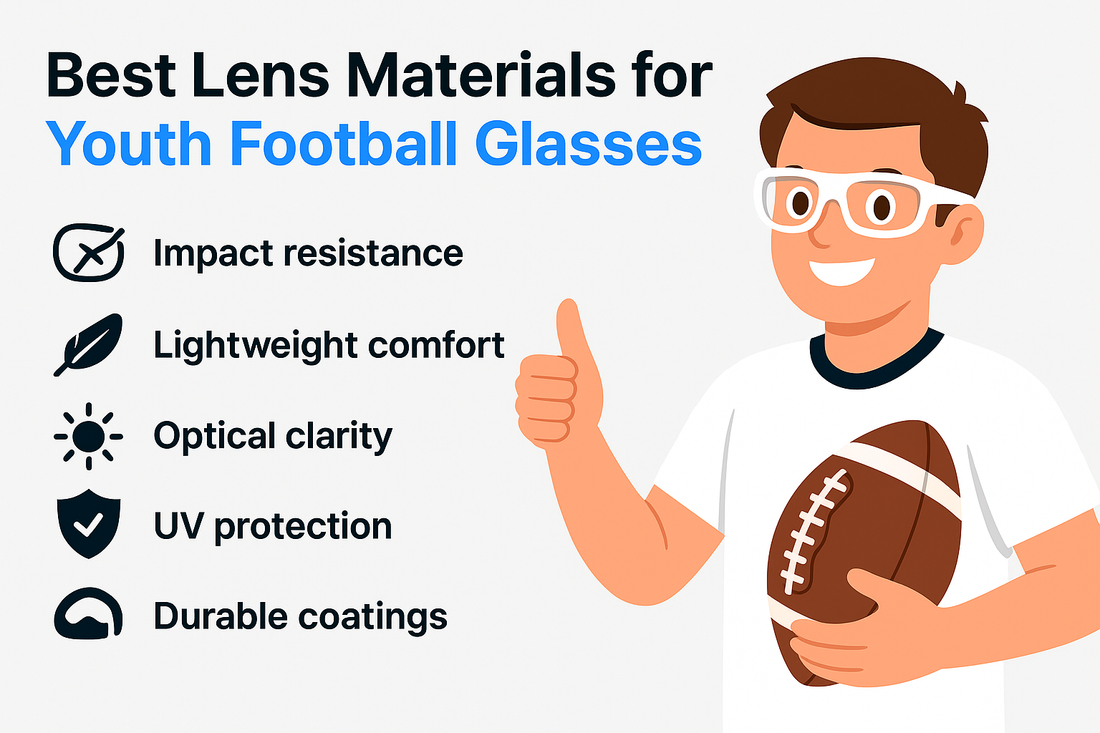
Best Lens Materials for Youth Football Glasses
When your young athlete suits up, vision is part of the uniform. The wrong lenses can fog, scratch, or weigh them down. The right lenses protect eyes, sharpen focus, and let kids play with confidence 🏈. Here is a clear guide to picking lens materials that stand up to tackles and deliver crisp vision all game long.
What really matters for youth sports lenses
- Impact resistance: Lenses must absorb hits from the ball, turf, or contact without cracking.
- Lightweight comfort: Less weight means fewer pressure points under a helmet and better all-game comfort.
- Optical clarity: Crisp vision helps with tracking passes and reading plays.
- UV protection: Full UVA and UVB blocking protects developing eyes ☀️.
- Durable coatings: Scratch resistance and anti-fog keep vision clear through action and weather.
Polycarbonate vs. Trivex: the top contenders
Polycarbonate is the go-to material for kids’ sports eyewear. It is exceptionally impact resistant, very light, and naturally blocks 100% of UV. For most young players, polycarbonate offers the best mix of safety and value.
Trivex delivers similar industry-leading impact protection with a few premium perks. It is often a touch lighter than polycarbonate and offers higher optical clarity, which some athletes notice as slightly sharper vision and better peripheral focus. That can help with tracking fast spirals and quick cuts.
Which should you choose? If you want maximum protection at a budget-friendly price, polycarbonate is excellent. If you prioritize the lightest feel and a crisper view, Trivex is a smart upgrade 🛡️. Both are strong choices for football, and both are far safer than materials like glass.
What about high-index lenses?
High-index lenses can be thinner for strong prescriptions, but they are generally less impact resistant and heavier than polycarbonate or Trivex. For contact sports, most eye care pros recommend sticking with polycarbonate or Trivex. If your child has a high prescription, ask about frame design and lens edge treatments that protect while keeping thickness manageable.
Must-have coatings and treatments
- Scratch-resistant hard coat: Reinforces the lens surface against turf, faceguards, and frequent cleaning.
- Anti-fog treatment: Helps prevent fogging from sweat, breath, or weather swings inside a helmet. Look for permanent or long-lasting formulas.
- Anti-reflective (AR) coating: Reduces glare and halos from stadium lights and afternoon sun. Backside AR is especially helpful to cut reflections behind the lens.
- Hydrophobic and oleophobic layers: Shed water and sweat, resist smudges, and make quick wipes with a microfiber cloth more effective 👓.
Tints, photochromic, and mirrors
Gray keeps colors neutral for bright midday practices. Brown or amber can boost contrast for tracking the ball against grass and sky. Photochromic lenses darken outdoors and lighten indoors, which is convenient for variable light. A subtle mirror can help cut glare, but make sure light transmission remains game-appropriate.
Helmet and frame compatibility
Choose sport frames that fit comfortably under a football helmet, with a secure strap and soft nose pads. A snug, stable fit reduces fogging and keeps lenses centered for clear vision. Wrap styles offer extra side coverage without adding bulk.
Quick care tips for season-long clarity
- Rinse dust and grit with water before wiping to avoid micro-scratches.
- Use a microfiber cloth and lens-safe cleaner, not a jersey or paper towels.
- Store glasses in a hard case when not on the field.
Looking for the right eyewear? Here are our top picks based on today’s article:
Based on today’s topic, here are a few of our top picks you might love:
- Steph Kids Sports Glasses in Black and Blue
- Winner Kids Sports Glasses in Black
- Lebron Kids (White W/Blue Mirror Sunglasses)
FAQs
How do I choose between polycarbonate and Trivex for my child?
Pick polycarbonate for excellent protection and value, or Trivex for similar safety with a lighter feel and slightly sharper optics.
What coatings help most for football?
Anti-fog, a quality scratch-resistant hard coat, and backside anti-reflective are the top trio for clear vision under a helmet and lights.
Can my kid get safe prescription lenses for tackle football?
Yes. Prescription polycarbonate or Trivex in a sport frame with a strap is a proven, protective setup.
Do tinted lenses improve performance under stadium lights?
Brown or amber can boost contrast, while AR coating cuts glare. Test in similar lighting to see what your child prefers.
Why avoid glass or high-index lenses for kids’ sports?
They are typically heavier and less impact resistant than polycarbonate or Trivex, which makes them a poorer choice for contact sports.



